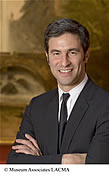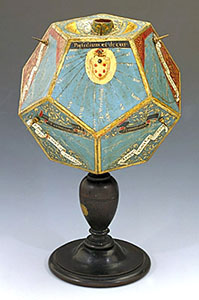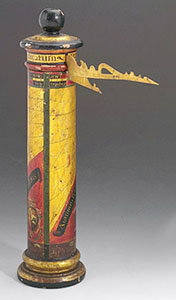All around the globe, financial traders, corporate executives, and consumers are
 holding back, keeping their wallets closed and sitting on their hands. No one — as recent economic statistics depressingly show — is doing much buying. So it comes as rather a shock to find out, as The Art Newspaper just revealed, that Michael Govan, the director of the Los Angeles County Museum of Art, is rushing in where others fear to tread. Govan has commissioned Jeff Koons to make a titanic life-size replica of a locomotive suspended from a crane for LACMA’s collection. Price tag: $25 million. The Art Newspaper called it the most expensive commission ever by a museum, and said LACMA has already spent about $1.7 million of the $2 million so far pledged for the piece. I have to wonder about Govan’s sanity.
holding back, keeping their wallets closed and sitting on their hands. No one — as recent economic statistics depressingly show — is doing much buying. So it comes as rather a shock to find out, as The Art Newspaper just revealed, that Michael Govan, the director of the Los Angeles County Museum of Art, is rushing in where others fear to tread. Govan has commissioned Jeff Koons to make a titanic life-size replica of a locomotive suspended from a crane for LACMA’s collection. Price tag: $25 million. The Art Newspaper called it the most expensive commission ever by a museum, and said LACMA has already spent about $1.7 million of the $2 million so far pledged for the piece. I have to wonder about Govan’s sanity.
Archives for March 2009
Reaching for the Stars
Last week, I wrote a piece on Forbes.com about UNESCO’s International Year of Astronomy (link), which kicked off in January. In it, I mentioned the “Galileo: Images of the Universe From Antiquity to the Telescope” exhibition opening this month at the Palazzo Strozzi in Florence.
I particularly like shows like this, exhibitions that link two disciplines, because they attract both audiences, in this case, people who are interested in either science or art.
Americans, I’ve been told by experts in arts participation, often favor one discipline — always attending the symphony for example but rarely going to an art museum, and vice versa.
At times like this, when cultural institutions are seeking to broaden their bases, cross-disciplinary shows are a good model.
My Forbes article was by no means a comprehensive roundup of all activities during the International Year of Astronomy. But afterwards I learned of a show like the one at the Palazzo Strozzi much closer to home. On April 4, the Franklin Institute in Philadelphia will open “Galileo, Medici and the Age of Astronomy,” which — judging from its website — also looks great. Alongside Galileo’s gear, there’ll be art and artifacts from the Medici family.
Here are two samples, both borrowed from the Institute and Museum of the History of Science, Florence: at right is a polyhedral sundial, with nine faces all telling the same time no matter which face is used, from 1587; below is a cylindrical sundial, whose horizontal brass arm marks time on the cylinder, from 1574-1587. From afar, they look like works of art.
I thought there was going to be another example of this in last Sunday’s New York Times, when I saw the City section’s article about “birding in a museum.” It put me in mind of a little tour at the Metropolitan Museum I had a few years ago: New York Audubon, with the Met, escorted bird-lovers around the collection, picking out and explaining images of birds from antiquity through the present. It was charming.
 Some of the hard-core birders present had probably not set foot in the Met before. But I bet they’ve been back.
Some of the hard-core birders present had probably not set foot in the Met before. But I bet they’ve been back.
The City section’s story, by the way, was about an Audubon water color show at the New-York Historical Society — not quite the same thing, but no doubt a good exhibition anyway.
Worried about arts contributions?
Then you may want to read this op-ed in today’s Wall Street Journal. As the author, Naomi Schaefer Riley, says, a similar effort to dictate to philanthropists in California died. But the activists have not let up. It will pay to be informed about this.
Why that YSL auction is good news
Welcome to my blog, which — I can say with certainty — will evolve; blogging is a new experience for me.
I’m going to cut right to the chase (you can read about my plans for this space in “about”) and start with what’s on everyone’s mind: the economy. Everyone’s scared. No one knows quite how to cope. It’s a rare cultural institution that hasn’t cut its budget. But last week’s lavish, record-setting Yves Saint Laurent auction in Paris is actually a good sign, not the last gasp of conspicuous consumption.
The total, you’ve probably read, reached $483.8 million, and one item, an Art Deco arm chair, fetched $28.3 million against an estimate of $2.6 million to $3.9 million! More important, the money spilled forth in every category of art, from Old Masters to German silver. Seventy-seven items sold for more than one million euros.
I don’t think the sale augurs well for the art market, near-term; it was a once-in-a-lifetime opportunity to buy high-quality objects with great provenance. But it does show that there are plenty of people with liquid assets who’ll spend money for something they really want.
 What if those people really want something everyone benefits from, like a strong museum or a vibrant theater scene, rather than a trophy object. That $28.3 million spent on a chair could have purchased, say, Franz Marc’s rare “Grazing Horses III,” which set a record at auction last year, and still left $4 million in the buyer’s pocket. It could have paid for the entire Museum of American Folk Art, which cost $22 million at its opening in 2001. It could have paid for almost 30% of the grants made by the National Endowment for the Arts in recent years.
What if those people really want something everyone benefits from, like a strong museum or a vibrant theater scene, rather than a trophy object. That $28.3 million spent on a chair could have purchased, say, Franz Marc’s rare “Grazing Horses III,” which set a record at auction last year, and still left $4 million in the buyer’s pocket. It could have paid for the entire Museum of American Folk Art, which cost $22 million at its opening in 2001. It could have paid for almost 30% of the grants made by the National Endowment for the Arts in recent years.
Even before the stock market plunged brutally yesterday — again — many experts believed that the “conspicuous philanthropy” that prevailed during the boom was dead. And maybe it is — if it’s defined as mega-gifts for buildings. But if the buyers in Paris last week were willing to spend so publicly, can’t cultural institutions convince people like them that a rescue gift is also a once-in-a-lifetime opportunity? And would these donors then be heroes and heroines?
To give them recognition, I would be willing to take nominations for a “national honor roll” published right here on this blog.
What about that other worry — that donations to arts groups are bound to decline when social needs are so great. It’s real, and there will be a drop, as there was after Katrina and other calamities. But, if past is prologue, there will be a rebound; most arts funding comes from individuals, not corporations or foundations.
Riding out these financial troubles won’t be easy, and even conspicuous philanthropy won’t save the many cultural groups that over-expanded. But there’s hope for those who can get back on a prudent course — with one caveat. If President Obama goes ahead with plans to limit the tax deductibility of charitable contributions, the woes will deepen. That’s a subject I’ll return to soon.
Real Clear Arts
This blog is about culture in America as seen through my lens, which is informed and colored by years of reporting not only on the arts and humanities, but also on business, philanthropy, science, government and other subjects…
